Visible Light-Driven Photocatalytic Degradation of Ciprofloxacin, Ampicillin and Erythromycin by Zinc Ferrite Immobilized on Chitosan
Abstract
:1. Introduction
2. Materials and Methods
2.1. Materials
2.2. Synthesis of ZnFe2O4 Particles
2.3. Synthesis of ZnFe2O4@Chitosan Particles
2.4. Characterization of ZnFe2O4@Chitosan Particles
2.5. Photocatalytic Degradation of CIP, AMP and ERY by ZnFe2O4@Chitosan
2.6. Evaluation of Reactive Oxygen Species Scavenging Capacity
2.7. Re-Useability and Stability of ZnFe2O4@Chitosan
3. Results and Discussion
3.1. Synthesis and Characterization of ZnFe2O4@Chitosan
3.2. Photodegradation Study
3.3. Effect of Operational Parameters
3.4. Proposed Mechanism for the Photodegradation of CIP, AMP and ERY by ZnFe2O4@Chitosan
3.5. Re-Useability and Stability of ZnFe2O4@Chitosan
4. Conclusions
Author Contributions
Funding
Data Availability Statement
Acknowledgments
Conflicts of Interest
References
- Hanna, N.; Sun, P.; Sun, Q.; Li, X.; Yang, X.; Ji, X.; Zou, H.; Ottoson, J.; Nilsson, L.E.; Berglund, B.; et al. Presence of antibiotic residues in various environmental compartments of Shandong province in eastern China: Its potential for resistance development and ecological and human risk. Environ. Int. 2018, 114, 131–142. [Google Scholar] [CrossRef] [PubMed]
- Zalewska, M.; Błażejewska, A.; Czapko, A.; Popowska, M. Antibiotics and Antibiotic Resistance Genes in Animal Manure–Consequences of Its Application in Agriculture. Front. Microbiol. 2021, 12, 610656. [Google Scholar] [CrossRef] [PubMed]
- Kumar, M.; Jaiswal, S.; Sodhi, K.K.; Shree, P.; Singh, D.K.; Agrawal, P.K.; Shukla, P. Antibiotics bioremediation: Perspectives on its ecotoxicity and resistance. Environ. Int. 2019, 124, 448–461. [Google Scholar] [CrossRef] [PubMed]
- Lv, J.; Zhang, L.; Chen, Y.; Ye, B.; Han, J.; Jin, N. Occurrence and distribution of pharmaceuticals in raw, finished, and drinking water from seven large river basins in China. J. Water Health 2019, 17, 477–489. [Google Scholar] [CrossRef]
- Lyu, J.; Chen, Y.; Zhang, L. Antibiotics in Drinking Water and Health Risks—China, 2017. China CDC Wkly. 2020, 2, 413–417. [Google Scholar] [CrossRef]
- Azanu, D.; Styrishave, B.; Darko, G.; Weisser, J.J.; Abaidoo, R.C. Occurrence and risk assessment of antibiotics in water and lettuce in Ghana. Sci. Total Environ. 2018, 622–623, 293–305. [Google Scholar] [CrossRef]
- Guruge, K.S.; Goswami, P.; Tanoue, R.; Nomiyama, K.; Wijesekara, R.; Dharmaratne, T.S. First nationwide investigation and environmental risk assessment of 72 pharmaceuticals and personal care products from Sri Lankan surface waterways. Sci. Total Environ. 2019, 690, 683–695. [Google Scholar] [CrossRef]
- Lorenzo, P.; Adriana, A.; Jessica, S.; Carles, B.; Marinella, F.; Marta, L.; Luis, B.J.; Pierre, S. Antibiotic resistance in urban and hospital wastewaters and their impact on a receiving freshwater ecosystem. Chemosphere 2018, 206, 70–82. [Google Scholar] [CrossRef]
- Tran, N.H.; Hoang, L.; Nghiem, L.D.; Nguyen, N.M.H.; Ngo, H.H.; Guo, W.; Trinh, Q.T.; Mai, N.H.; Chen, H.; Nguyen, D.D.; et al. Occurrence and risk assessment of multiple classes of antibiotics in urban canals and lakes in Hanoi, Vietnam. Sci. Total Environ. 2019, 692, 157–174. [Google Scholar] [CrossRef]
- Gholami, P.; Khataee, A.; Soltani, R.D.C.; Dinpazhoh, L.; Bhatnagar, A. Photocatalytic degradation of gemifloxacin antibiotic using Zn-Co-LDH@biochar nanocomposite. J. Hazard. Mater. 2020, 382, 121070. [Google Scholar] [CrossRef]
- Khaledian, H.R.; Zolfaghari, P.; Elhami, V.; Aghbolaghy, M.; Khorram, S.; Karimi, A.; Khataee, A. Modification of immobilized titanium dioxide nanostructures by argon plasma for photocatalytic removal of organic dyes. Molecules 2019, 24, 383. [Google Scholar] [CrossRef]
- Zhang, S.; Khan, I.; Qin, X.; Qi, K.; Liu, Y.; Bai, S. Construction of 1D Ag-AgBr/AlOOH plasmonic photocatalyst for degradation of tetracycline hydrochloride. Front. Chem. 2020, 8, 117. [Google Scholar] [CrossRef]
- Yang, X.; Chen, Z.; Zhao, W.; Liu, C.; Qian, X.; Zhang, M.; Wei, G.; Khan, E.; Ng, Y.H.; Ok, Y.S. Recent advances in photodegradation of antibiotic residues in water. Chem. Eng. J. 2021, 405, 126806. [Google Scholar] [CrossRef]
- Elmolla, E.S.; Chaudhuri, M. Degradation of amoxicillin, ampicillin and cloxacillin antibiotics in aqueous solution by the UV/ZnO photocatalytic process. J. Hazard. Mater. 2010, 173, 445–449. [Google Scholar] [CrossRef]
- Amariei, G.; Valenzuela, L.; Iglesias-Juez, A.; Rosal, R.; Visa, M. ZnO-functionalized fly-ash based zeolite for ciprofloxacin antibiotic degradation and pathogen inactivation. J. Environ. Chem. Eng. 2022, 10, 107603. [Google Scholar] [CrossRef]
- Mishra, S.; Kumar, P.; Samanta, S.K. Microwave Catalytic Degradation of Antibiotic Molecules by 2D Sheets of Spinel Nickel Ferrite. Ind. Eng. Chem. Res. 2020, 59, 15839–15847. [Google Scholar] [CrossRef]
- Becker, A.; Kirchberg, K.; Marschall, R. Magnesium ferrite (MgFe2O4) nanoparticles for photocatalytic antibiotics degradation. Z. Phys. Chem. 2020, 234, 645–654. [Google Scholar] [CrossRef]
- Li, Y.; He, J.; Zhang, K.; Hong, P.; Wang, C.; Kong, L.; Liu, J. Oxidative degradation of sulfamethoxazole antibiotic catalyzed by porous magnetic manganese ferrite nanoparticles: Mechanism and by-products identification. J. Mater. Sci. 2020, 55, 13767–13784. [Google Scholar] [CrossRef]
- Yi, H.; Lai, C.; Almatrafi, E.; Huo, X.; Qin, L.; Fu, Y.; Zhou, C.; Zeng, Z.; Zeng, G. Efficient antibiotics removal via the synergistic effect of manganese ferrite and MoS2. Chemosphere 2022, 288, 132494. [Google Scholar] [CrossRef]
- Zhong, Y.; Shih, K.; Diao, Z.; Song, G.; Su, M.; Hou, L.; Chen, D.; Kong, L. Peroxymonosulfate activation through LED-induced ZnFe2O4 for levofloxacin degradation. Chem. Eng. J. 2021, 417, 129225. [Google Scholar] [CrossRef]
- Senapati, K.K.; Roy, S.; Borgohain, C.; Phukan, P. Palladium nanoparticle supported on cobalt ferrite: An efficient magnetically separable catalyst for ligand free Suzuki coupling. J. Mol. Catal. A Chem. 2012, 352, 128–134. [Google Scholar] [CrossRef]
- Yao, C.; Zeng, Q.; Goya, G.; Torres, T.; Liu, J.; Wu, H.; Ge, M.; Zeng, Y.; Wang, Y.; Jiang, J. ZnFe2O4 nanocrystals: Synthesis and magnetic properties. J. Phys. Chem. C 2007, 111, 12274–12278. [Google Scholar] [CrossRef]
- Abbasian, A.R.; Afarani, M.S. One-step solution combustion synthesis and characterization of ZnFe2O4 and ZnFe1.6O4 nanoparticles. Appl. Phys. A 2019, 125, 721. [Google Scholar] [CrossRef]
- Hammond, C. The Basics of Crystallography and Diffraction; Oxford University Press: New York, NY, USA, 1997. [Google Scholar]
- Gherca, D.; Pui, A.; Cornei, N.; Cojocariu, A.; Nica, V.; Caltun, O. Synthesis, characterization and magnetic properties of MFe2O4 (M=Co, Mg, Mn, Ni) nanoparticles using ricin oil as capping agent. J. Magn. Magn. Mater. 2012, 324, 3906–3911. [Google Scholar] [CrossRef]
- Bell, A.T. The impact of nanoscience on heterogeneous catalysis. Science 2013, 299, 1688–1691. [Google Scholar] [CrossRef]
- Shang, M.; Wang, W.; Sun, S.; Zhou, L.; Zhang, L. Bi2WO6 nanocrystals with high photocatalytic activities under visible light. The J. Phys. Chem. C 2008, 112, 10407–10411. [Google Scholar] [CrossRef]
- Hagfeldt, A.; Graetzel, M. Light-induced redox reactions in nanocrystalline systems. Chem. Rev. 1995, 95, 49–68. [Google Scholar] [CrossRef]
- Nadeem, K.; Shahid, M.; Mumtaz, M. Competing crystallite size and zinc concentration in silica coated cobalt ferrite nanoparticles. Prog. Nat. Sci. Mat. Intern. 2014, 24, 199–204. [Google Scholar] [CrossRef]
- Corazzari, I.; Nisticò, R.; Turci, F.; Faga, M.G.; Franzoso, F.; Tabasso, S.; Magnacca, G. Advanced physico-chemical characterization of chitosan by means of TGA coupled on-line with FTIR and GCMS: Thermal degradation and water adsorption capacity. Polym. Degrad. Stab. 2015, 112, 1–9. [Google Scholar] [CrossRef]
- De Britto, D.; Campana-Filho, S.P. Kinetics of the thermal degradation of chitosan. Thermochim. Acta 2007, 465, 73–82. [Google Scholar] [CrossRef]
- Avetta, P.; Nisticò, R.; Faga, M.G.; D’Angelo, D.; Boot, E.A.; Lamberti, R.; Martorana, S.; Calza, P.; Fabbri, D.; Magnacca, G. Hernia-repair prosthetic devices functionalised with chitosan and ciprofloxacin coating: Controlled release and antibacterial activity. J. Mater. Chem. B 2014, 2, 5287–5294. [Google Scholar] [CrossRef]
- Hilding, J.; Grulke, E.A.; Sinnott, S.B.; Qian, D.; Andrews, R.; Jagtoyen, M. Sorption of Butane on Carbon Multiwall Nanotubes at Room Temperature. Langmuir 2001, 17, 7540–7544. [Google Scholar] [CrossRef]
- De Britto, D.; Campana-Filho, S.P. A kinetic study on the thermal degradation of N,N,N-trimethylchitosan. Polym. Degrad. Stab. 2004, 84, 353–361. [Google Scholar] [CrossRef]
- Zeng, L.; Qin, C.; Wang, L.; Li, W. Volatile compounds formed from the pyrolysis of chitosan. Carbohydr. Polym. 2011, 83, 1553–1557. [Google Scholar] [CrossRef]
- Xu, Y.; Wu, S.; Li, X.; Huang, Y.; Wang, Z.; Han, Y.; Wu, J.; Meng, H.; Zhang, X. Synthesis, characterization, and photocatalytic degradation properties of ZnO/ZnFe2O4 magnetic heterostructures. New J. Chem. 2017, 41, 15433–15438. [Google Scholar] [CrossRef]
- Xue, H.; Li, Z.; Wang, X.; Fu, X. Facile synthesis of nanocrystalline zinc ferrite via a self-propagating combustion method. Mater. Lett. 2007, 61, 347–350. [Google Scholar] [CrossRef]
- Sharma, A.; Dutta, R.K. Se-doped CuO NPs/H2O2/UV as a highly efficient and sustainable photo-Fenton catalytic system for enhanced degradation of 4-bromophenol. J. Clean. Prod. 2018, 185, 464–475. [Google Scholar] [CrossRef]
- Ulyankina, A.; Molodtsova, T.; Gorshenkov, M.; Leontyev, I.; Zhigunov, D.; Konstantinova, E.; Lastovina, T.; Tolasz, J.; Henych, J.; Licciardello, N.; et al. Photocatalytic degradation of ciprofloxacin in water at nano-ZnO prepared by pulse alternating current electrochemical synthesis. J. Water Process Eng. 2021, 40, 101809. [Google Scholar] [CrossRef]
- Al-Musawi, T.J.; Rajiv, P.; Mengelizadeh, N.; Arghavan, F.S.; Balarak, D. Photocatalytic efficiency of CuNiFe2O4 nanoparticles loaded on multi-walled carbon nanotubes as a novel photocatalyst for ampicillin degradation. J. Mol. Liq. 2021, 337, 116470. [Google Scholar] [CrossRef]
- Alalm, M.G.; Ookawara, S.; Fukushi, D.; Sato, A.; Tawfik, A. Improved WO3 photocatalytic efficiency using ZrO2 and Ru for the degradation of carbofuran and ampicillin. J. Hazard. Mater. 2016, 302, 225–231. [Google Scholar] [CrossRef]
- Eskandari, M.; Goudarzi, N.; Moussavi, G. Application of low-voltage UVC light and synthetic ZnO nanoparticles to photocatalytic degradation of ciprofloxacin in aqueous sample solutions. Water Environ. J. 2018, 32, 58–66. [Google Scholar] [CrossRef]
- Selvamani, P.S.; Vijaya, J.J.; Kennedy, L.J.; Mustafa, A.; Bououdina, M.; Sophia, P.J.; Ramalingam, R.J. Synergic effect of Cu2O/MoS2/rGO for the sonophotocatalytic degradation of tetracycline and ciprofloxacin antibiotics. Ceram. Int. 2021, 47, 4226–4237. [Google Scholar] [CrossRef]
- Malakootian, M.; Nasiri, A.; Amiri Gharaghani, M. Photocatalytic degradation of ciprofloxacin antibiotic by TiO2 nanoparticles immobilized on a glass plate. Chem. Eng. Commun. 2020, 207, 56–72. [Google Scholar] [CrossRef]
- Sharma, G.; Gupta, V.K.; Agarwal, S.; Bhogal, S.; Naushad, M.; Kumar, A.; Stadler, F.J. Fabrication and characterization of trimetallic nano-photocatalyst for remediation of ampicillin antibiotic. J. Mol. Liq. 2018, 260, 342–350. [Google Scholar] [CrossRef]
- Vignesh, K.; Rajarajan, M.; Suganthi, A. Photocatalytic degradation of erythromycin under visible light by zinc phthalocyanine-modified titania nanoparticles. Mater. Sci. Semicond. Process. 2014, 23, 98–103. [Google Scholar] [CrossRef]
- Fakhri, A.; Rashidi, S.; Tyagi, I.; Agarwal, S.; Gupta, V.K. Photodegradation of Erythromycin antibiotic by γ-Fe2O3/SiO2 nanocomposite: Response surface methodology modeling and optimization. J. Mol. Liq. 2016, 214, 378–383. [Google Scholar] [CrossRef]
- Jassal, P.; Khajuria, R.; Sharma, R.; Debnath, P.; Verma, S.; Johnson, A.; Kumar, S. Photocatalytic degradation of ampicillin using silver nanoparticles biosynthesised by Pleurotus ostreatus. BioTechnologia 2020, 101, 5–14. [Google Scholar] [CrossRef]
- Sohrabnezhad, S.; Pourahmad, A.; Karimi, M.F. Magnetite-metal organic framework core@shell for degradation of ampicillin antibiotic in aqueous solution. J. Solid State Chem. 2020, 288, 121420. [Google Scholar] [CrossRef]
- Singh, P.; Priya, B.; Shandilya, P.; Raizada, P.; Singh, N.; Pare, B.; Jonnalagadda, S. Photocatalytic mineralization of antibiotics using 60% WO3/BiOCl stacked to graphene sand composite and chitosan. Arabian J. Chem. 2019, 12, 4627–4645. [Google Scholar] [CrossRef]
- Priya, B.; Shandilya, P.; Raizada, P.; Thakur, P.; Singh, N.; Singh, P. Photocatalytic mineralization and degradation kinetics of ampicillin and oxytetracycline antibiotics using graphene sand composite and chitosan supported BiOCl. J. Molecul. Catal. A Chem. 2016, 423, 400–413. [Google Scholar] [CrossRef]
- Saha, S.; Saha, T.K.; Karmaker, S.; Islam, Z.; Demeshko, S.; Frauendorf, H.; Meyer, F. Solar Light-Assisted Oxidative Degradation of Ciprofloxacin in Aqueous Solution by Iron (III) Chelated Cross-Linked Chitosan Immobilized on a Glass Plate. Catalysts 2022, 12, 475. [Google Scholar] [CrossRef]
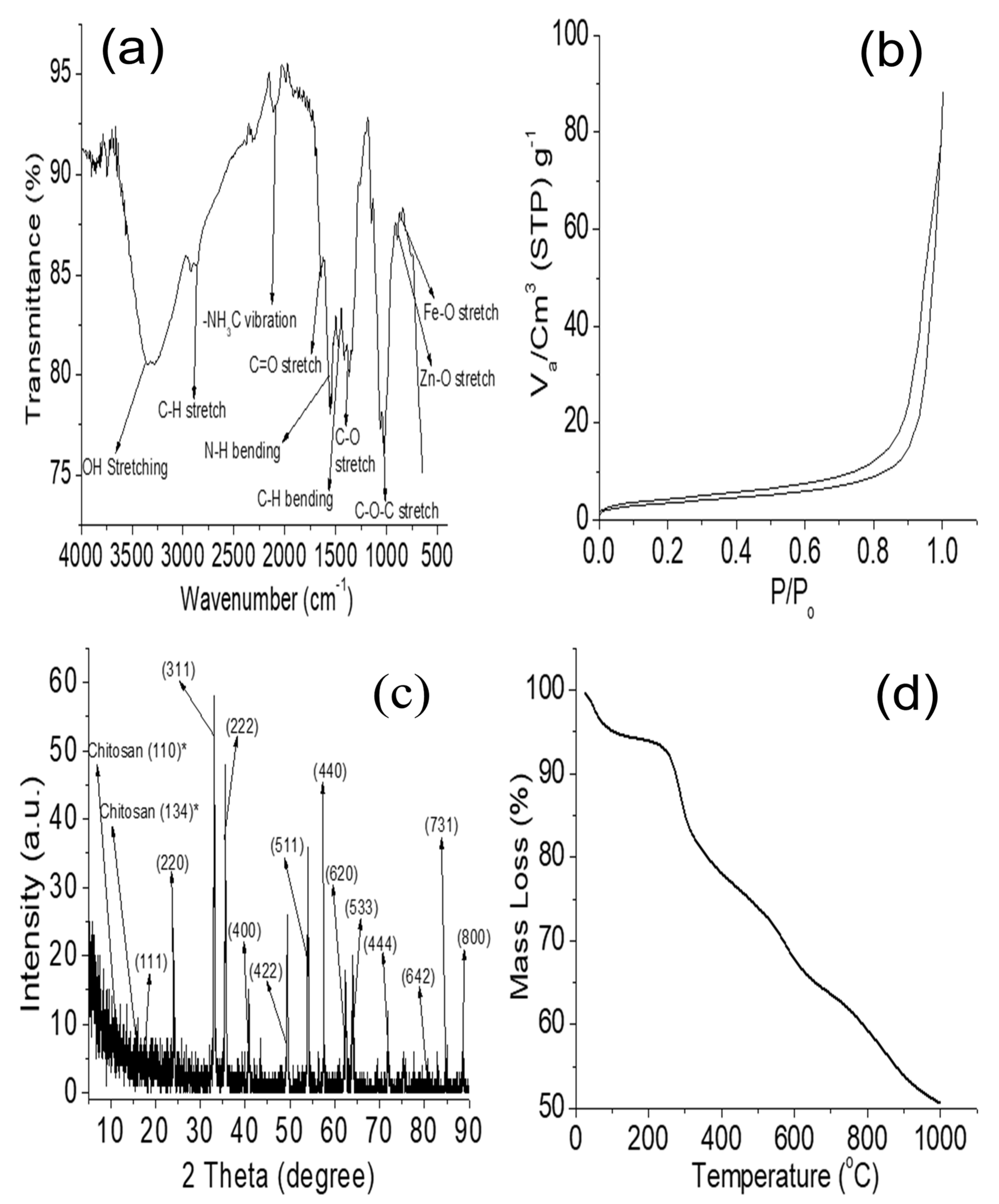
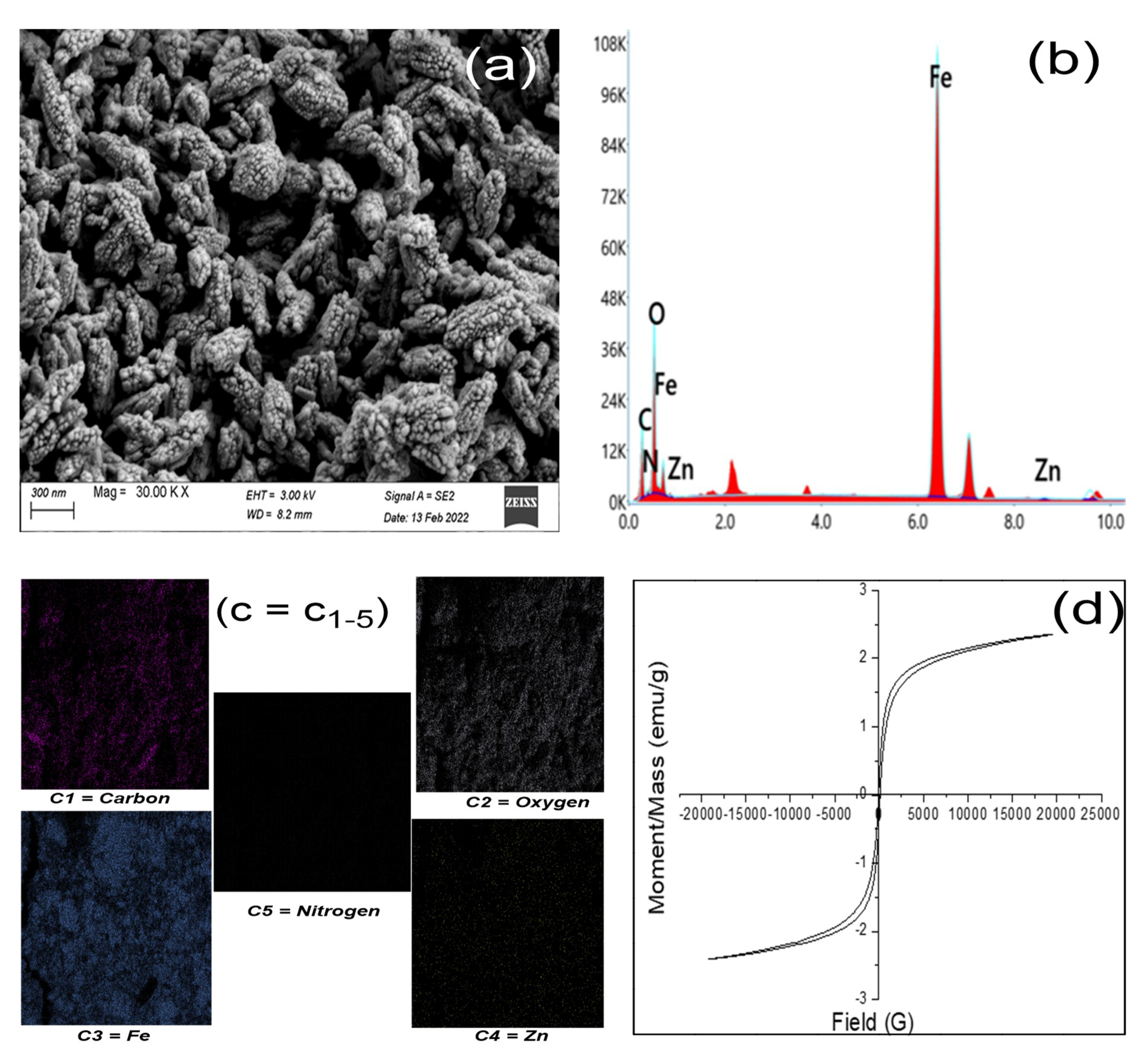
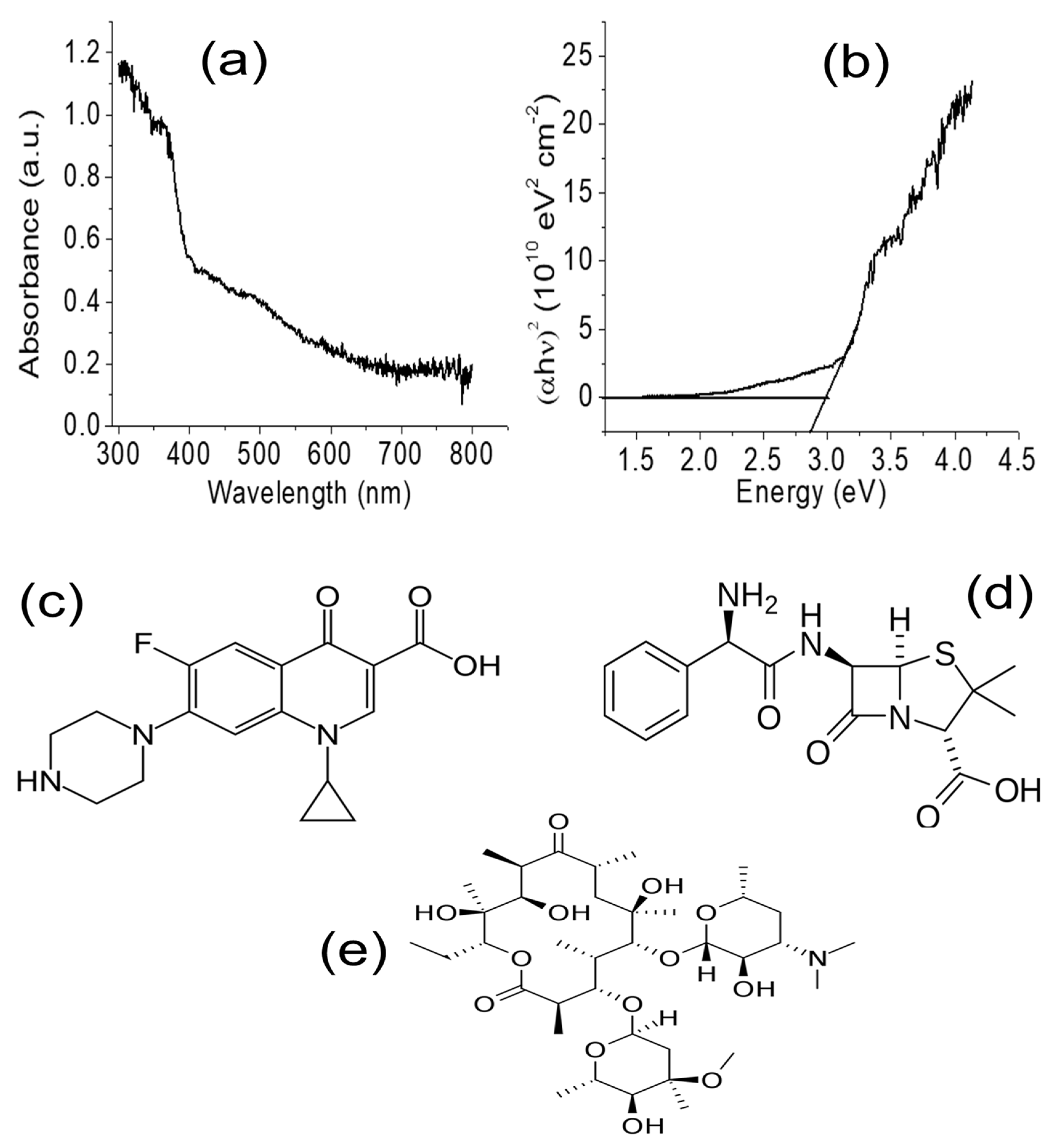
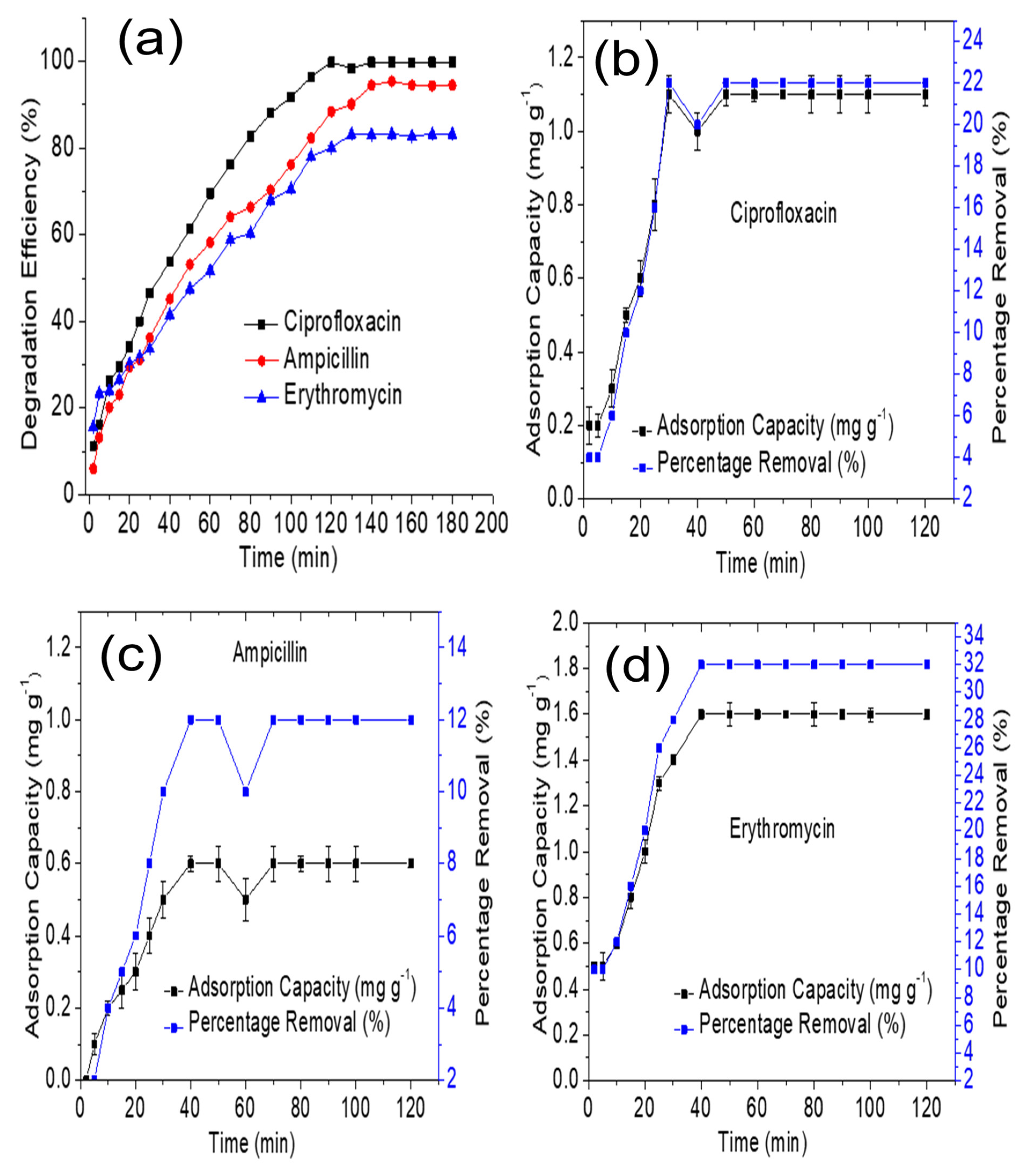
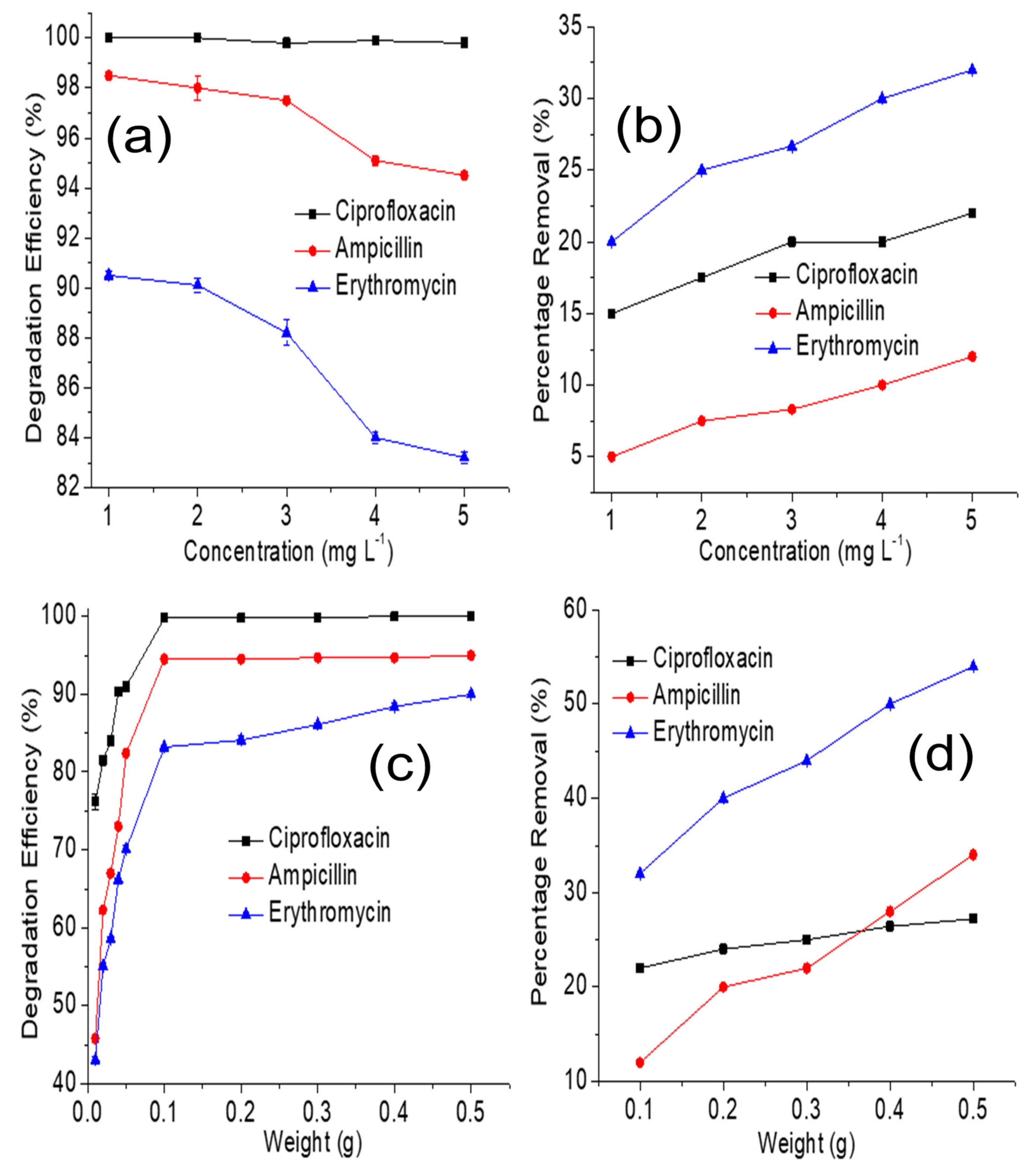
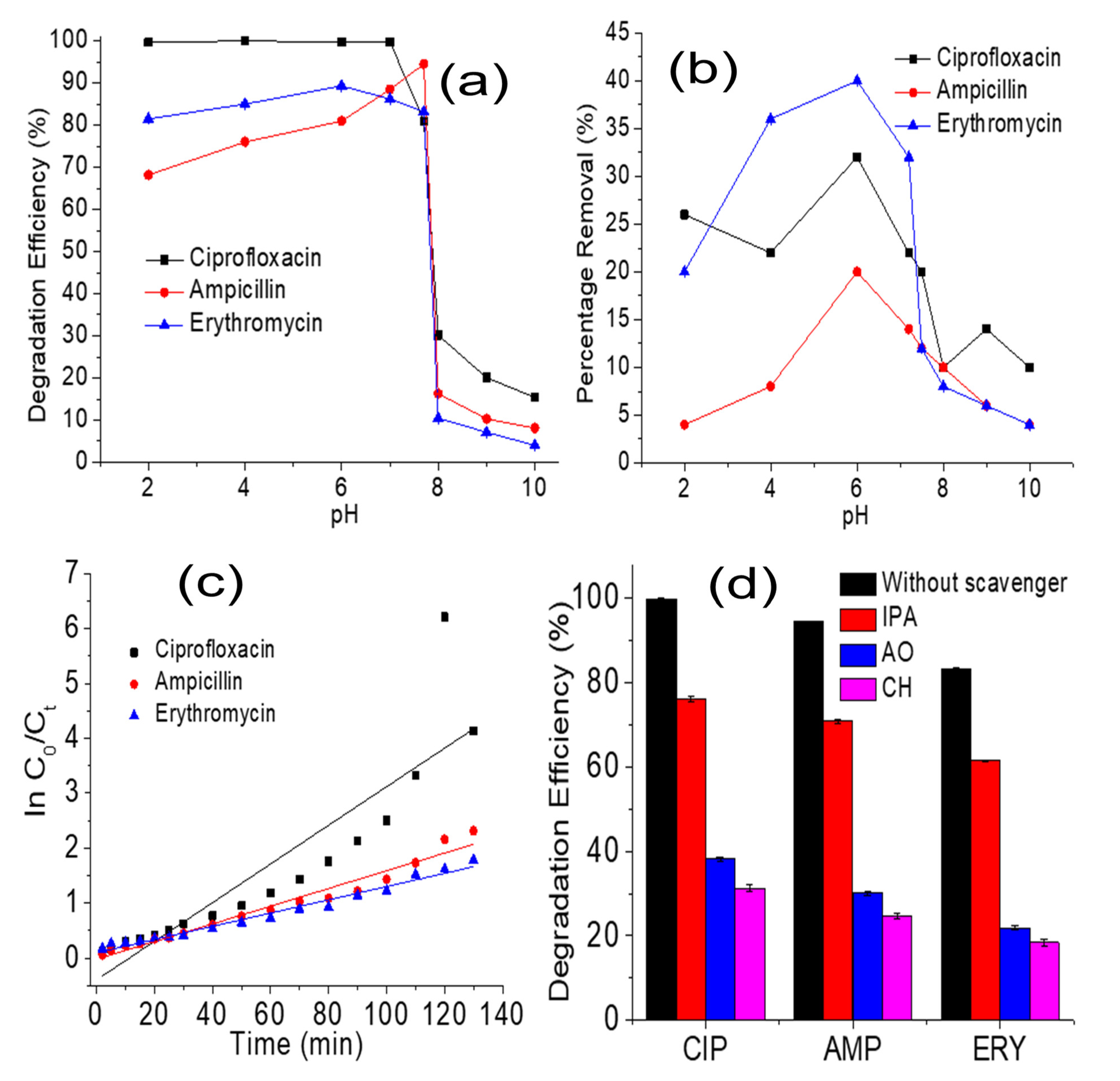
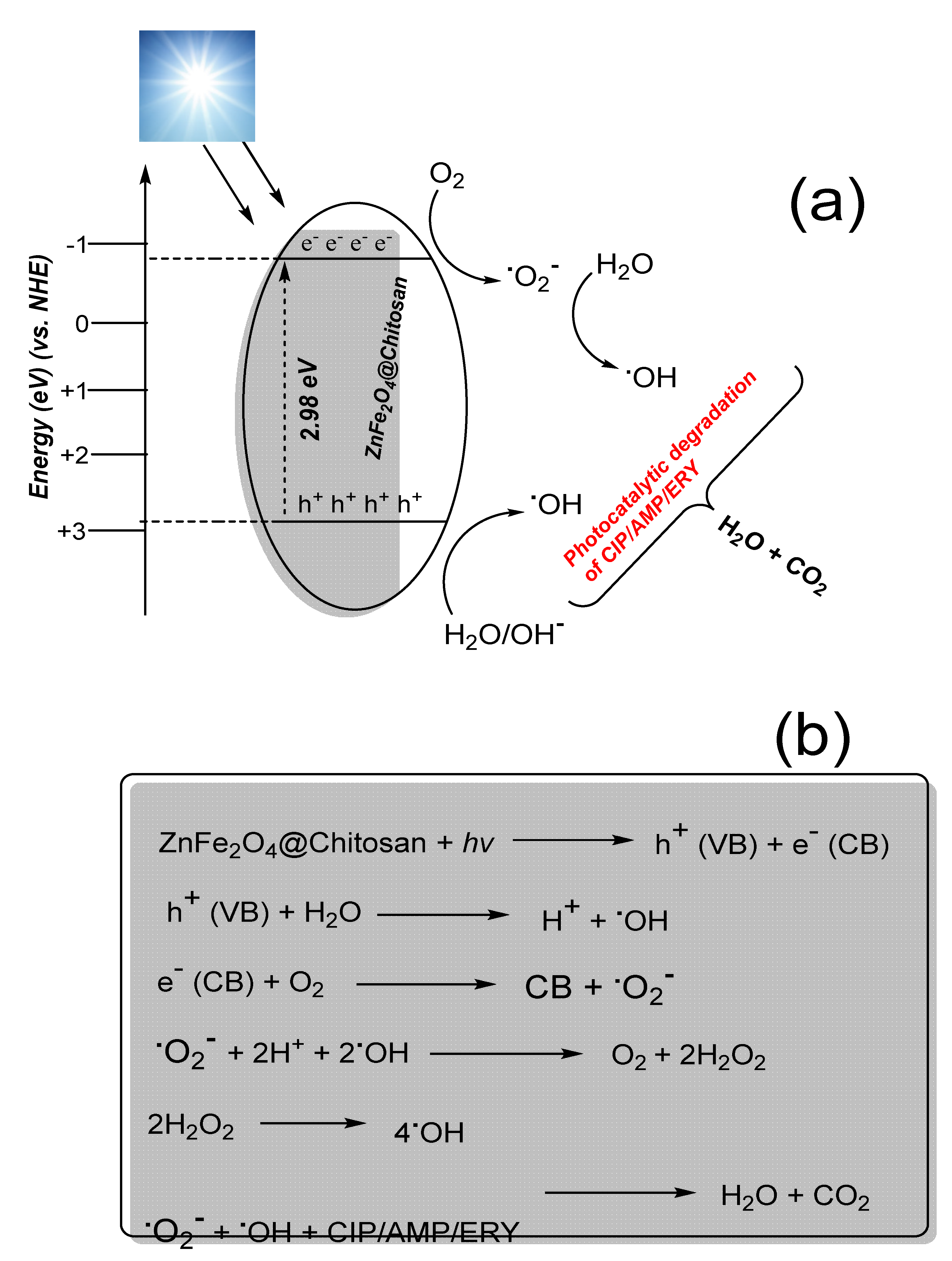
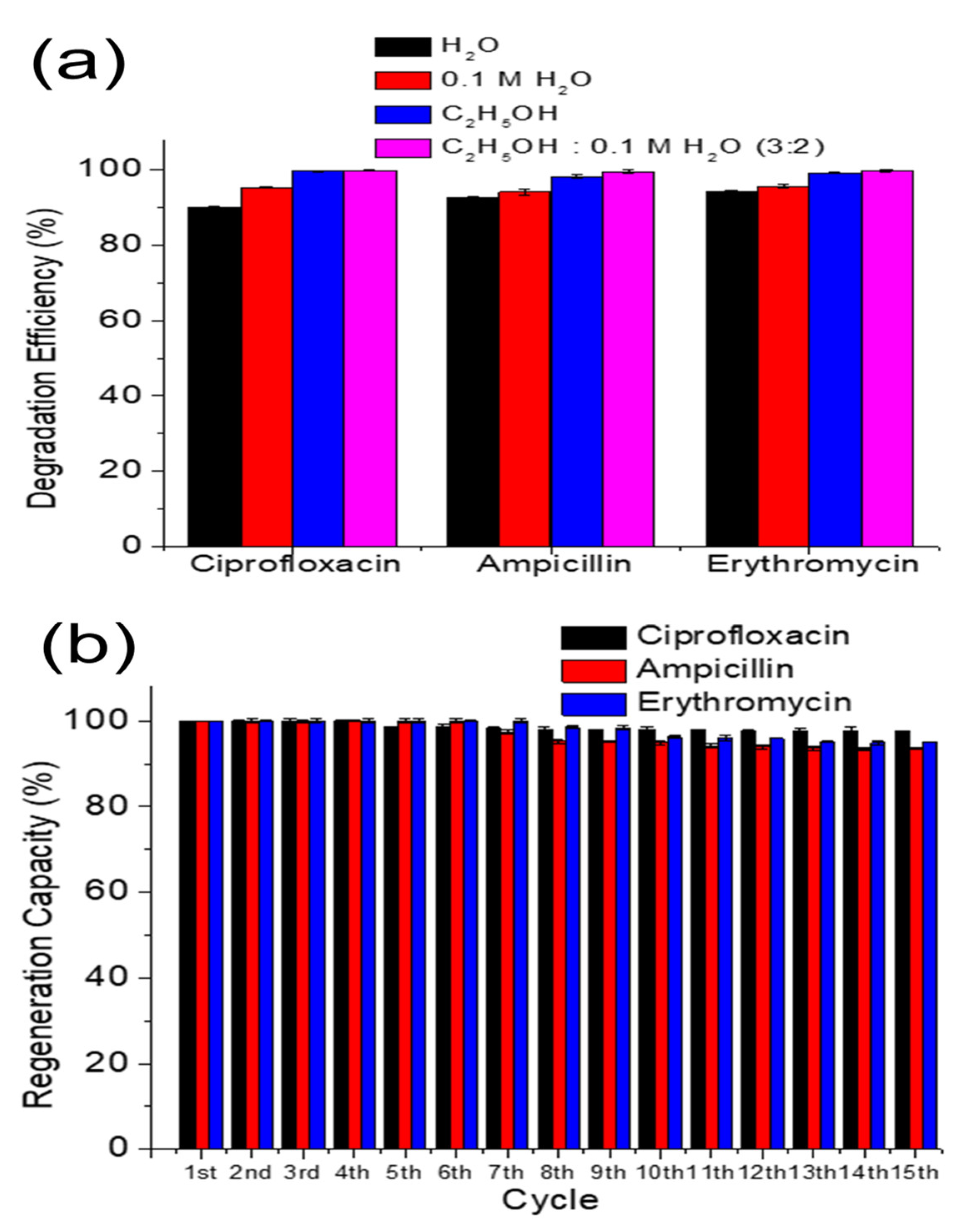
| Material | Antibiotic | DE (%) | LIS | AC (g L−1) | Conc (mg L−1) | Stability (%) | Reference |
|---|---|---|---|---|---|---|---|
| Cu2O/MoS2/rGO | CIP | 55.00 | 150 W halogen lamp | 0.30 | 10.00 | - | [43] |
| TiO2 on glass | CIP | 92.00 | 6 W UV-C lamp | 1.00 | 5.00 | - | [44] |
| ZnO | CIP | 93.00 | 8 W Hg fluorescent | 0.50 | 5.00 | - | [39] |
| ZnO | CIP | 100.00 | 9 W Hg UV lamp | 0.15 | 10.00 | - | [42] |
| MWCNTs-CuNiFe2O4 | AMP | 100.00 | 36 W UV | 0.50 | 25.00 | 93.72 (8th cycle) | [40] |
| Ru/WO3/ZrO2 | AMP | 96.00 | 150 W Xe lamp | 1.00 | 50.00 | 92.00 (2nd cycle) | [41] |
| La/Cu/Zr trimetallic | AMP | 86.00 | Sunlight | 0.10 | 50.00 | 59.00 (6th cycle) | [45] |
| Znpc–TiO2 | ERY | 74.21 | 300 W Xe arc lamp | 0.40 | 1 × 105 M | - | [46] |
| γ-Fe2O3/SiO2 | ERY | 87.17 | 15 W UV-C lamp | 0.50 | 6.00 | - | [47] |
| Ag-NP | AMP | 96.50 | Sunlight | 0.17 | 10.00 | - | [48] |
| FeSi@MN | AMP | 70.00 | Sunlight | 0.60 | 100.00 | 63.00 (4th cycle) | [49] |
| WO3/BiOCl/Chitosan | AMP | 75.00 | Solar light | 0.50 | * 1 × 10−4 | 67.00 (10th cycle) | [50] |
| BiOCl/Chitosan | AMP | 75.00 | Solar light | 1.00 | * 1 × 10−4 | 67.00 (10th cycle) | [51] |
| FeIII-CS-GLA | CIP | 90.30 | Solar light | - | ** 50 | - | [52] |
| ZnFe2O4@Chitosan | CIP AMP ERY | 99.80 94.50 83.20 | Visible-light simulation (150 W Xe light) | 1.00 1.00 1.00 | 5.00 5.00 5.00 | 97.60 (15th cycle) 93.50 (15th cycle) 95.00 (15th cycle) | This study |
Publisher’s Note: MDPI stays neutral with regard to jurisdictional claims in published maps and institutional affiliations. |
© 2022 by the authors. Licensee MDPI, Basel, Switzerland. This article is an open access article distributed under the terms and conditions of the Creative Commons Attribution (CC BY) license (https://creativecommons.org/licenses/by/4.0/).
Share and Cite
Hassan Mohamed, N.A.; Shamma, R.N.; Elagroudy, S.; Adewuyi, A. Visible Light-Driven Photocatalytic Degradation of Ciprofloxacin, Ampicillin and Erythromycin by Zinc Ferrite Immobilized on Chitosan. Resources 2022, 11, 81. https://doi.org/10.3390/resources11100081
Hassan Mohamed NA, Shamma RN, Elagroudy S, Adewuyi A. Visible Light-Driven Photocatalytic Degradation of Ciprofloxacin, Ampicillin and Erythromycin by Zinc Ferrite Immobilized on Chitosan. Resources. 2022; 11(10):81. https://doi.org/10.3390/resources11100081
Chicago/Turabian StyleHassan Mohamed, Nehad Ahmed, Rehab Nabil Shamma, Sherien Elagroudy, and Adewale Adewuyi. 2022. "Visible Light-Driven Photocatalytic Degradation of Ciprofloxacin, Ampicillin and Erythromycin by Zinc Ferrite Immobilized on Chitosan" Resources 11, no. 10: 81. https://doi.org/10.3390/resources11100081
APA StyleHassan Mohamed, N. A., Shamma, R. N., Elagroudy, S., & Adewuyi, A. (2022). Visible Light-Driven Photocatalytic Degradation of Ciprofloxacin, Ampicillin and Erythromycin by Zinc Ferrite Immobilized on Chitosan. Resources, 11(10), 81. https://doi.org/10.3390/resources11100081









